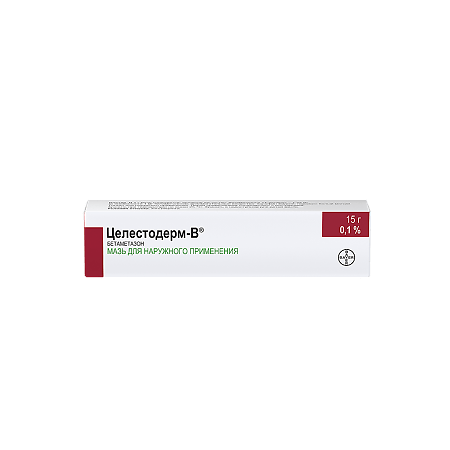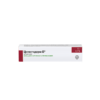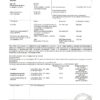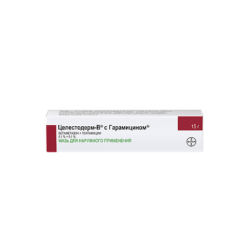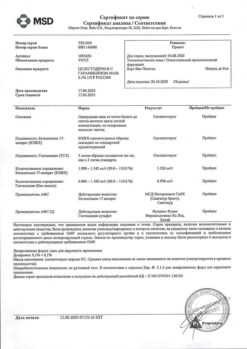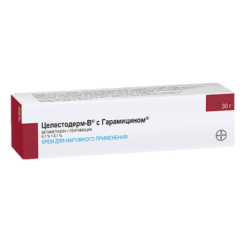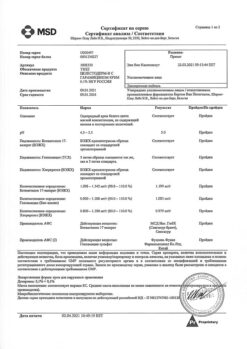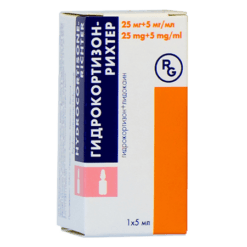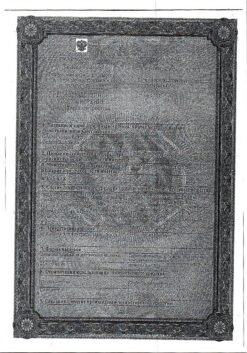No products in the cart.
Celestoderm B, ointment 0.1% 15 g
€6.08 €5.32
Description
Pharmgroup:
Glucocorticosteroid for topical use.
Pharmic action:
Celestoderm-B is a GKS for topical use; it has anti-inflammatory local, anti-allergic, anti-edema and anti-proliferative effects.
Betamethasone has anti-inflammatory and antiallergic effect by inhibition of release of cytokines and inflammatory mediators, reduction of arachidonic acid metabolism, induction of formation of lipocortins which have anti-edema activity, reduction of vascular permeability.
The micro dispersion of this glucocorticosteroid (GCS) in a non-greasy, odorless, non-marking ointment or cream base that is easy to wash off ensures effective penetration into the skin and rapid onset of action.
Indications
Indications
Inflammatory skin diseases amenable to glucocorticosteroid (GCS) therapy:
– eczema (atonic, childhood, coin-shaped);
— contact dermatitis;
— seborrheic dermatitis;
— neurodermatitis;
– solar dermatitis;
— exfoliative dermatitis;
— radiation dermatitis;
— intertriginous dermatitis;
— psoriasis;
– anogenital and senile itching.
Pharmacological effect
Pharmacological effect
Pharmaceutical group:
glucocorticosteroid for local use.
Pharmaceutical action:
Celestoderm-V – GCS for external use; has local anti-inflammatory, anti-allergic, anti-edematous and anti-proliferative effects.
Betamethasone has an anti-inflammatory and antiallergic effect by inhibiting the release of cytokines and inflammatory mediators, reducing the metabolism of arachidonic acid, inducing the formation of lipocortins, which have anti-edematous activity, and reducing vascular permeability.
Microdispersion of this glucocorticosteroid (GCS) in a non-greasy, odorless, non-marking ointment or cream base that does not leave marks on clothing ensures effective penetration into the skin and a rapid onset of action.
Special instructions
Special instructions
If there is no effect of treatment within 2 weeks, it is recommended to consult your doctor to clarify the diagnosis and treatment. If irritation or hypersensitivity is observed when using the drug, treatment should be stopped and the patient should be given another therapy.
Any side effects of systemic corticosteroids, including suppression of adrenal cortex function, may also be observed when using local corticosteroids, especially in children. Systemic absorption of local corticosteroids may increase with long-term use, treatment of large areas of the body, or use of occlusive dressings, especially in children.
Systemic absorption of gentamicin when applied topically may be increased when applied to large areas of skin, especially during long-term treatment or in the presence of cracked skin. In such cases, the development of adverse events characteristic of gentamicin when used systemically, especially in children, is possible.
When antibiotics are used locally, growth of insensitive microflora, including fungal ones, is occasionally observed. In this case, treatment must be stopped and appropriate therapy prescribed. Celestoderm-B with Garamycin is indicated for external use only and is not intended for use in ophthalmology.
Celestoderm-B with Garamycin can be used to treat children over 6 months of age. Children may be more susceptible to the effects of local corticosteroids, which cause suppression of the hypothalamic-pituitary-adrenal axis than older patients. This is due to higher absorption of the drug in children due to the larger ratio of surface area to body weight.
Active ingredient
Active ingredient
Betamethasone
Composition
Composition
1 g of ointment contains:
active substance: betamethasone 17-valerate – 1.22 mg (equivalent to 1 mg betamethasone);
excipients: liquid paraffin – 100.0 mg, white soft paraffin – 898.78 mg.
Pregnancy
Pregnancy
Due to the fact that the safety of the use of local corticosteroids in pregnant women has not been established, the prescription of drugs of this class during pregnancy is justified only if the benefit to the mother clearly outweighs the possible harm to the fetus.
GCS should not be used during pregnancy for a long time or in large doses.
Since it has not yet been established whether GCS, when applied topically and systemically absorbed, can penetrate into breast milk, a decision should be made to stop breastfeeding or discontinue the drug, taking into account how necessary its use is for the mother.
Contraindications
Contraindications
– Hypersensitivity to any of the components of the drug.
– Skin tuberculosis.
– Skin manifestations of syphilis.
– Chicken pox.
– Simple herpes.
– Fungal skin diseases.
– Vaccination period and post-vaccination skin reactions.
– Lactation period.
– Pregnancy (long-term treatment of large areas of skin).
– Children up to 6 months.
With caution:
– Pregnancy (in the absence of criteria for contraindications), especially in the 1st trimester.
– Long-term treatment of large areas of skin, especially in children.
– If there are cracks in the skin or if occlusive dressings are used.
Side Effects
Side Effects
Local reactions: skin irritation (itching, erythema), burning sensation, dry skin, folliculitis, hypertrichosis, acne, hypopigmentation, perioral dermatitis, allergic contact dermatitis.
When using occlusive dressings: skin maceration, secondary infection, skin atrophy, stretch marks, prickly heat.
With prolonged treatment or application to a large surface: the development of systemic side effects characteristic of GCS is possible: weight gain, osteoporosis, increased blood pressure, edema, ulceration of the mucous membrane of the gastrointestinal tract, exacerbation of hidden foci of infection, hyperglycemia, agitation, insomnia, menstrual irregularities.
Children receiving local corticosteroids may experience the following side effects: suppression of the function of the hypothalamic-pituitary-adrenal system, Cushing’s syndrome, growth retardation, delayed weight gain, increased intracranial pressure. Symptoms of adrenal suppression in children include decreased plasma cortisol levels and lack of response to ACTH stimulation. Increased intracranial pressure is manifested by bulging of the fontanel, headache, and bilateral papilledema.
Overdose
Overdose
Symptoms: excessive or prolonged use of local corticosteroids can cause inhibition of the function of the pituitary-adrenal system, which can cause the development of secondary adrenal insufficiency and the appearance of symptoms of hypercortisolism, including Cushing’s syndrome.
A single overdose of gentamicin is not accompanied by the appearance of any symptoms. Long-term use in doses exceeding the recommended ones can lead to a significant growth of insensitive flora, including fungal flora, in the affected area.
Treatment: Appropriate symptomatic treatment is indicated. Acute symptoms of hypercortisolism are usually reversible. If necessary, correction of electrolyte imbalance is indicated. In case of chronic toxic effects, gradual withdrawal of GCS is recommended. If the growth of microorganisms is uncontrolled, appropriate antibacterial or antifungal treatment should be selected.
Storage conditions
Storage conditions
Store at a temperature not exceeding 25°C.
Manufacturer
Manufacturer
Schering-Plau Labeau N.V., Belgium
Additional information
| Conditions of storage | Store at a temperature not exceeding 25 ° C. |
|---|---|
| Manufacturer | Schering-Plough Labo N.V., Belgium |
| Medication form | topical ointment |
| Brand | Schering-Plough Labo N.V. |
Other forms…
Related products
Corticosteroid hormones
Buy Celestoderm B, ointment 0.1% 15 g with delivery to USA, UK, Europe and over 120 other countries.

